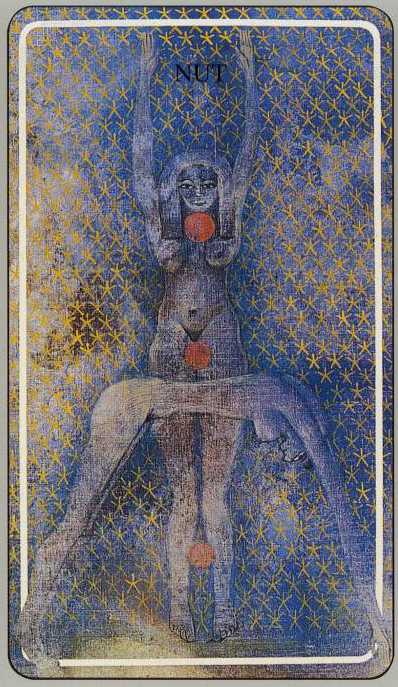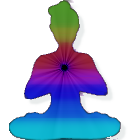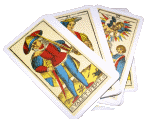
Haindl Tarot
MOTHER OF SWORDS - NUT
Most people know Nut (sometimes called Mother of the Nile) as the night sky, arched over the Earth, her body filled with stars. She appears very slim, almost a ribbon in some pictures, with the suggestion that she reaches all about the Earth. Hermann Haindl has based his image on temples in Dendera and Edfu, and the ceiling of the tomb chamber of Ramses VI. The image is very ancient, for Nut, like Kali in India, goes back to primordial times, with her Libyan version, Neith, described by Vicki Noble as possibly "the oldest goddess in the world."
Some images show Nut in intercourse with her brother Geb, the Earth, who appears lying on his back with Nut arched over him (the opposite of the "missionary position" by which the Christian Church dictated that the man must always be on top). The obelisk symbolized Geb's penis as well as the power of Ra. The scene makes Egypt one of the few cultures to picture the Sky as female and the Earth as male. But Nut is the night sky, maintaining the idea of the day (the light) as male (Ra, the Sun), and the dark (the night, the ancient and mysterious) as female.
Nut sometimes appears standing upright on her toes, as shown here in the version behind the arching woman. In fact, the two images are the same, for the upright posture represents Nut as if seen from beneath. It appears on the inside of coffins (Haindl saw this in Medinet Habu and on a coffin in the Egyptian Museum in Cairo.). Nut reaches over the dead person who would see her from beneath, in contrast to her profile in the Sky. Night and death become symbols of each other in this double image of the Goddess. Death covers us entirely, the way the night covers the Earth. While Mother Nut confronts us with the fear of darkness and death, she also shelters us. Her presence in the coffin would help to assure the passage of the soul through the chaos of death to the order of a new life in the Other World. Just as the Sun is reborn, so is the soul. By showing both forms of Nut - that which appears in the temple and that which appears in the grave – the card illustrates the way the Goddess acts for the individual person as well as for the cosmos.
Like many other peoples, the Egyptians established myths to explain the Sun's constant disappearance and return. These stories do not explain in the modern scientific sense, but rather express the way we experience and confront the mighty realities of nature. Different stories dealt with the Sun at night. As Ra, the Sun travels in a boat (steered by Thoth) through the sky by day, and under the Earth at night. Myths that focus on Nut, however, tell us that the Mother eats the Sun in the evening, that it travels through her body and reemerges in the morning. In the Mother of Swords we see this event as the three red circles moving along the upright body. The number three reminds us of the Empress, just as the shape of arching Nut suggests the Ur Rune, and, therefore, the High Priestess. The night sky is the Goddess as a totality, the High Priestess and the Empress combined in a single figure.
Nut eating the Sun links her again to Kali, who, on a much greater scale, "eats" the life energy of the universe, returning it to primal night. Unlike Kali, Nut is not the original mover of creation (at least not in the later myths that have come down to us). As we saw with the Ace of Swords, the first existence belongs to Nun, the dark chaotic waters. Atum (later joined to Ra) emerges, and the two together produce Shu and Tifnut, the wind and dew. And yet, other texts refer to Ra as the son of Nut.
The dew represented the primal pattern in the same way that Hagall, the hailstone, represented it for the much colder Scandinavians. When we learn that the Egyptians also compared Nut to a cow (linking her to Hathor), whose udder gives forth the Milky Way, we realize the remarkable links that exist between the African south of Egypt and the European north.
Pictures of Nut show her surrounded by stars, the way the Sky appears on a cloudless night. These stars always take the same shape, shown on the card. They resemble a human form with arms and legs spread out in celebration, the children of the Great Mother.
The pharaohs sometimes called themselves the sons and consorts of Nut. Pepi Il described himself as living "between the thighs of Nut." Later images presented the pharaoh as sitting on the lap of Isis. The Egyptian word nutrit, for woman, meant "Little Goddess."
DIVINATORY MEANINGS
In readings, Nut suggests someone mysterious, a private person who may seem distant or unapproachable to those around her. She can be very loving, even devoted, but she always keeps something of herself to herself. She maintains her own autonomy in all situations, even when passionately in love, or caring for her children. This may cause people to resent her, but if they do respect her need to keep something within, they will find that she gives greatly to those she loves. A person living out the myth of Nut will prefer night to day, the darkness to the light. She will care more for the sense of mystery than for explanation.
REVERSED
Reversed, the Mother of Swords may show the need for privacy exaggerated. The person may find it hard to connect with other people, to respond to those who try to reach her emotionally. Alternatively it may show the person's need for autonomy threatened. She may find herself in a relationship with someone who demands too much from her. Or, she may feel a conflict in herself between her desire for quiet and mystery on the one side and her love for others, especially her children, on the other.










